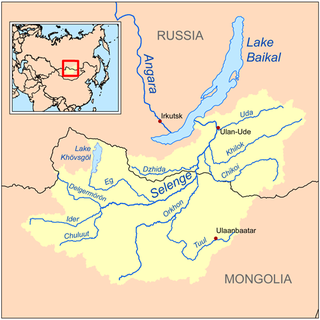Top Qs
Timeline
Chat
Perspective
Orkhon River
Longest river in Mongolia From Wikipedia, the free encyclopedia
Remove ads
The Orkhon River (/ˈɔːrkɒn/ OR-kon)[1][a] is the longest river in Mongolia.
This article needs additional citations for verification. (January 2020) |


It rises in the Khangai Mountains in the Tsenkher sum of Arkhangai aimag at the foot of the Suvraga Khairkhan mountain.[3] From there, it crosses the border into Övörkhangai aimag and follows the upper Orkhon valley in an eastern direction until it reaches Kharkhorin. On this stretch, very close to the Orkhon, the Ulaan Tsutgalan river features a waterfall, ten metres (33 ft) wide and twenty metres (66 ft) high,[4] which is a popular destination for tourists.
From Kharkhorin it flows northwards until it reaches Bulgan aimag, and then north-east to join the Selenge River next to Sükhbaatar city in Selenge aimag, close to the Russian border.[5] The Selenge then flows further north into Russia and Lake Baikal.
With 1,124 km (698 mi), the Orkhon is longer than the Selenge, making it the longest river in Mongolia. Major tributaries of the Orkhon river are the Tuul River and Tamir River.
There are two sets of ancient ruins along the river valley: Khar Balgas, the ancient capital of the Uyghur Kingdom and Karakorum, the ancient capital of the Mongol Empire. Pyotr Kuzmich Kozlov excavated several Xiongnu Imperial tombs in the area of the river valley.
Fish in the Orkhon River include pike, carp, perch, taimen and catfish.
UNESCO lists the Orkhon Valley as a World Heritage Site.
Remove ads
Usage
In 2014, almost 40 million m3 of water was withdrawn from the river for domestic, livestock, cropland and industrial use.[6]
See also
- Khöshöö Tsaidam Monuments (World heritage site)
- List of rivers of Mongolia
Notes
- Mongolian: Орхон гол [ɔ́rχɞɴ‿ɢ̊ɜɬ]; Old Chinese: 安侯水 *arhoushui^ [2]
References
Further reading
External links
Wikiwand - on
Seamless Wikipedia browsing. On steroids.
Remove ads


